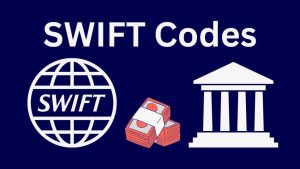Introduction

In the fast-paced world of international banking and finance, the SWIFT code is vital for ensuring smooth, secure, and efficient cross-border transactions. But what exactly is a SWIFT code, and why is it so crucial in the global financial landscape? This article aims to demystify the concept of SWIFT codes, exploring their structure, purpose, and significance in international banking.
Understanding SWIFT Codes
What is a SWIFT Code?
A SWIFT code, or a Bank Identifier Code (BIC), is a unique alphanumeric code used to identify banks and financial institutions globally. It is crucial in facilitating international money transfers and communication between banks.
The Structure of a SWIFT Code
SWIFT codes are typically 8 to 11 characters long and are structured in a specific format:
- Bank Code (4 characters): Represents the bank’s code.
- Country Code (2 characters): Indicates the country where the bank is located.
- Location Code (2 characters): Specifies the city or location of the bank.
- Branch Code (3 characters, optional): Identifies specific branches of a bank.
Decoding a SWIFT Code: An Example
Consider the SWIFT code ABCDUS33XXX:
- ABCD represents the bank code.
- The U.S. signifies the United States.
- 33 indicates a specific location within the U.S.
- XXX refers to the bank’s head office.
The Role of SWIFT Codes in International Banking
Facilitating Global Transactions
SWIFT codes are essential for international wire transfers, as they help accurately direct funds to the intended recipient’s bank.
Ensuring Security and Efficiency
Using SWIFT codes minimizes the risk of errors in international transactions, ensuring funds are transferred securely and efficiently.
How to Find a SWIFT Code
Checking Bank Documents
Your bank’s SWIFT code can typically be found on bank statements or online banking portals.
Online SWIFT Code Directories
Various online resources offer comprehensive databases of SWIFT codes worldwide.
Frequently Asked Questions About SWIFT Codes
Are SWIFT Codes the Same as IBANs?
SWIFT codes and International Bank Account Numbers (IBANs) serve different purposes. While a SWIFT code identifies banks, an IBAN identifies individual bank accounts.
Can SWIFT Codes Change?
Banks may change their SWIFT codes due to mergers, acquisitions, or restructuring.
How Often are SWIFT Codes Used?
SWIFT codes are used daily in millions of transactions globally, underscoring their importance in international finance.
Final Thoughts
As we navigate the complex world of international finance, the importance of tools like SWIFT codes cannot be overstated. They stand as beacons of efficiency and security, guiding our financial transactions across the global stage.
So, the next time you’re involved in an international transfer, remember the vital role played by that seemingly simple string of characters – your SWIFT code.
Frequently Asked Questions (FAQs)
What is a SWIFT Code?
- Answer: A SWIFT code, or a Bank Identifier Code (BIC), is a unique alphanumeric code that identifies banks and financial institutions globally. It is crucial for facilitating international money transfers and communication between banks.
How is a SWIFT Code Structured?
- Answer: A SWIFT code is typically 8 to 11 characters long, including a Bank Code (4 characters), a Country Code (2 characters), a Location Code (2 characters), and an optional Branch Code (3 characters).
Can SWIFT Codes Change?
- Answer: Yes, a bank’s SWIFT code can change due to mergers, acquisitions, or internal restructuring.
How Can I Find a Bank’s SWIFT Code?
- Answer: You can find a bank’s SWIFT code on bank statements, through online banking portals, or by using online SWIFT code directories.
Are SWIFT Codes the Same as IBANs?
- Answer: No, SWIFT codes and IBANs serve different purposes. A SWIFT code identifies the bank involved in the transaction, while an IBAN identifies the individual bank account.
What is the Role of SWIFT Codes in International Banking?
- Answer: SWIFT codes are essential in international banking for facilitating global transactions, ensuring funds are accurately directed to the intended recipient’s bank, and providing a secure, efficient way to conduct cross-border money transfers.
Why are SWIFT Codes Important for International Transactions?
- Answer: SWIFT codes minimize the risk of errors in international transactions, ensuring that funds are transferred securely and efficiently to the correct bank and branch.
How Often are SWIFT Codes Used in Financial Transactions?
- Answer: SWIFT codes are used in millions of transactions globally daily, highlighting their critical role in international finance.
Conclusion
In conclusion, the article provides an insightful and comprehensive understanding of SWIFT codes, their structure, purpose, and critical role in the global financial landscape.
SWIFT codes, or Bank Identifier Codes, are essential tools in international banking, facilitating secure and efficient cross-border transactions.
These unique codes ensure that funds are accurately directed to the correct bank and branch, significantly reducing the risk of errors in international money transfers.
The detailed breakdown of a SWIFT code’s structure helps demystify how these codes are composed and what each segment represents, from the bank code to the branch code.
Additionally, the article addresses common queries and misconceptions, clarifying the difference between SWIFT codes and IBANs and explaining how to find a bank’s SWIFT code.
Overall, the article underscores the indispensable role of SWIFT codes in modern finance.
They are more than just a string of characters; they are the backbone of international banking, ensuring that despite the vast distances and different financial systems, money can move securely and efficiently across borders.
This makes them a vital component of the global economy, facilitating trade, investment, and personal transactions worldwide.
